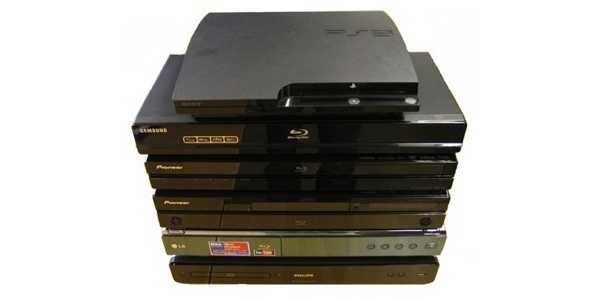
We decided to take five middle price range BD-Live enabled Blu-ray players from leading manufacturers and put them to a test. To compare the standalone players to an old favourite we took PlayStation 3 Slim to test drive as well.
Philips BDP-7300
Pioneer BDP-120
Pioneer BDP-320
PS3 Slim
Samsung BD-P1600
LG BD390
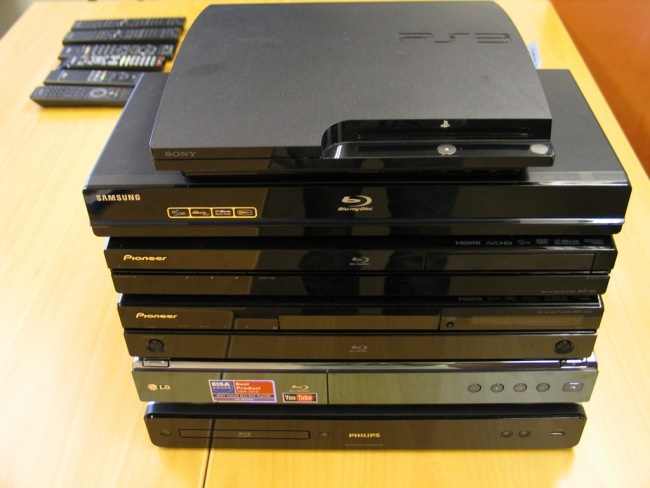
From bottom to top: Philips BDP7300, LG BD390, Pioneer BDP-320, Pioneer BDP-120, Samsung BD-P1600, PS3 Slim
Features
The six units have quite a bit in common feature-wise. Each of them includes HDMI and component outputs, USB, Ethernet, optical Toslink output for digital audio and support for DTS HD and Dolby TrueHD audio. They also support DVD upscaling to Full HD resolution -- a feature which has become common in DVD players as well.
The biggest differences are found in the support for additional file formats although DivX and AVCHD video are supported by most of the players. We'll cover more of that in a dedicated section. The LG BD390 and PlayStation 3 Slim both have an integrated WiFi while Samsung BD-P1600 requires an external WiFi dongle. Other players only support wired Ethernet. The LG and PS3 are also the only players to support DLNA/UPNP shares. There is a YouTube app in LG BD390 and Samsung BD-P1600. Unfortunately, because we had European versions of the players the LG BD390 didn't have the Netflix app. Philips BDP7300 has outputs for six channel (5.1) analog audio and the LG BD390 includes eight channel (7.1) analog output.
One thing I need to mention straight away. The Pioneer players' USB ports only act as a connection for storing BD-Live content. That means that you cannot use thumb drives to play any kind of files on the player.
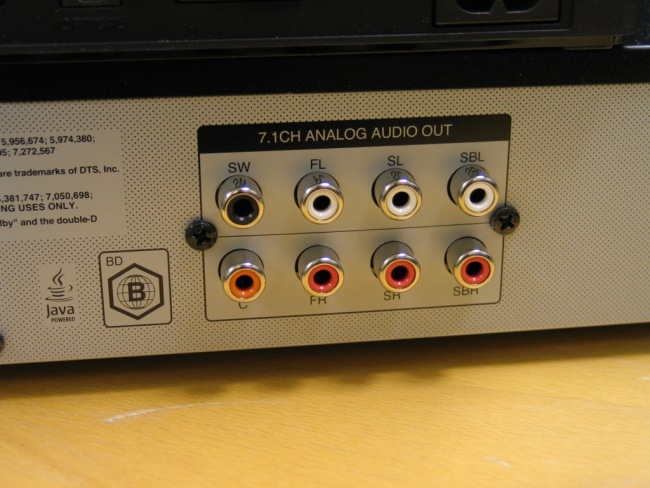
The only 7.1 analog surround sound output of the review
LG BD390,





PS3 Slim,




Philips BDP-7300,




Samsung BD-P1600,



Pioneer BDP-120,


Pioneer BDP-320,


Appearance
This is far from scientific but for some it's important to have a stylish and sleek device next to their designer flat screen TV. Every one has a taste of its own so take this section for what it is -- an opinion.

Pioneer BDP-120

Samsung BD-P1600

Pioneer BDP-320

Sony PlayStation 3 Slim
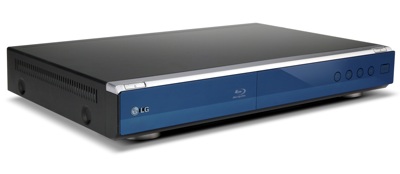
LG BD390
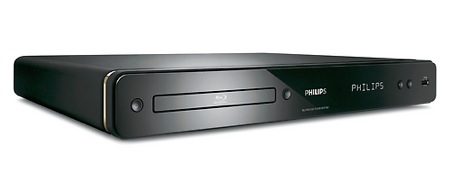
Philips BDP7300
All the players sport the endlessly trendy color black which really doesn't surprise anyone. Some of the players have some chrome or silver colored details but that's about it. However the subtle differences in buttons and shapes leave me with a clear winner. The retroish on/off and play button as well as the stylish overall look of the device wins the trophy for Pioneer BDP-320. It is also the only player to have a disc tray in the center. I guess symmetry is my thing.
LG BD390 and Samsung BD-P1600 both have a hidden tray behind the front panel. It does improve the look of the unit when tray is closed and hidden but the open front panel will not win any beauty contests. In the BD-P1600 there are no visible buttons either when the front panel is closed which makes the device look cleaner but the usability of the touch sensitive buttons (the only ones in the devices) takes a hit when you have to open the panel first to reach them. Would be nice to have at least the "open tray" button which pushes the panel open visible at all times.
The Pioneer BDP-120 is not as stylish as its bigger brother even though it shares some of its looks. I guess it's the lack of cool buttons. Philips BDP7300 looks a bit cheap with its plexiglass front panel and rounded corners. The Philips is also the only player to have an open USB port in the front without any kind of cover for it. It is somewhat ugly but does defeat the back panel USB ports in usability hands down. In the Samsung you can stick the USB drive in either a USB slot behind the front panel which means you have to keep it open or reach for the back panel USB port.
There are some size differences in the front displays as well. LG's display is the largest and therefore also the clearest, Pioneer BDP-120 has the smallest and the rest of the standalone players go somewhere in the middle with approximately the same size displays. The PlayStation 3 Slim doesn't have a display which may be a factor to some.
The PlayStation 3 Slim will probably divide opinions because of its form factor. Either you want a rectangular shaped device or something different which in this case is the PS3. The game console also is the only one with slot-loading disc drive which in many cases is easier and faster to load.
Pioneer BDP-320,





LG BD390,




Samsung BD-P1600,




Philips BDP-7300,



Pioneer BDP-120,



PS3 Slim,



Remote
There are distinct differences in the remote controls as well. Pioneer seems to rely on versatile remotes, however that also makes them the most complicated ones of the bunch. There are dozens of identical rectangular buttons which makes it hard to distinguish the different functions and the small print between the buttons doesn't help that much.
Samsung is the only remote to have a glossy surface which loves fingerprints. I prefer a matte finish. The remote for the Philips BDP7300 is by far the smallest and it doesn't feel as solid as the remotes from LG, Samsung and Pioneer. However the button placement and apperance earn some points. LG's remote is the only one to hide rarely used buttons (TV controls, etc) behind a cover. Unfortunately because it's really stiff you often just pick up the TV remote to do the job.
There is no actual remote control with PlayStation 3 Slim. If you don't want to invest some additional money in a Bluetooth remote you'll need to control the PS3 with a DualShock 3 controller. It's not the worst thing in the world when you get the hang of it but is definitely miles away from a real remote. For most of the functions you need to access the menu and also scroll through the options, even for simple tasks like muting. If you're thinking of using the PS3 as a Blu-ray player I recommend spending some extra bucks to buy the remote. And that is not only because the console controller sucks for movies, but also because the PS3 remote is really a good one.
One more note about remotes. All the reviewed players support standard HDMI CEC controlling. Each of the manufacturers have a different name for it but its essentially the same thing. Whether it goes by KURO Link, Anysee, Simplink, Easylink or some other name, It allows you to control TV with the BD player remote and vice versa. However, there are some compatibility issues between them. In this test we found out that Pioneer's KURO Link was the only one that is not compatible with our LG TV. All the other players, including the PS3, supported the power on/off function which allows to turn both TV and BD player on and off with one press of a button.
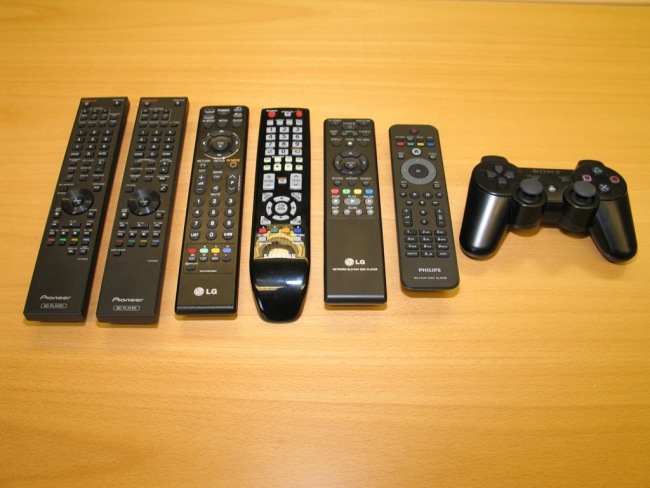
From left to right: Pioneer BDP-120, Pioneer BDP-320, LG HDTV, Samsung BD-P1600, LG BD390, Philips BDP7300, PS3 Slim
LG BD390,




Philips BDP-7300,



Pioneer BDP-120,



Pioneer BDP-320,



Samsung BD-P1600,


PS3 Slim,


UI and menus
The menu structures and graphical elements in most of the players are far from perfect. There is little eye candy -- whether it's vanity or not -- in most of the players. Especially the Pioneer BDP-120 suffers from boring and bland menus, low resolution icons and other graphics and lack of animation. It inevitably makes you feel like you are using an unfinished product. We also found out that Pioneer BDP-320 uses low resolution in the subtitles for DivX video, which makes them pixelated and hard to read. There is no such problem with subtitles on Blu-ray movies however.
LG uses animated icons and trasition effects in its BD390 which makes it the most refreshing user interface amongst the standalone players. Philips and Samsung rely mainly on high resolution graphics. Samsung's UI is somewhat sluggish and the responsiveness is not where it should be. Therefore fast scrolling through menus is hard.
With LG BD390 and Samsung BD-P1600 you get the YouTube application. Both of them have a nice user interface with options for search, most popular videos, recent videos, etc. All in all the LG's visual experience is a bit above the Samsung though. Unfortunately neither of them do not support YouTube HD material.
The user interface of the PlayStation 3 is far better than most of the standalone players but the menu structure for video playback is confusing. As mentioned earlier, you really want the Bluetooth remote control so you can access most of the functions without using the cluttered menu. The PS3 uses the highest resolution available throughout the user interface which the way it should be in all BD players.
LG BD390,





PS3 Slim,




Philips BDP-7300,




Samsung BD-P1600,



Pioneer BDP-320,



Pioneer BDP-120,


Performance
In this section we'll go through the startup and loading speeds of the devices. For us -- and most likely for some of you as well -- performance is a key factor in choosing a BD player. The manufacturers tend to tweak the performance as the competition get fiercer. It happened with DVD players and it will certainly happen with Blu-ray players.
As manufacturers have been developing Blu-ray players for couple of years now, we expected a solid performance from all of them. However, to our surprise we experienced huge differences in both startup and movie loading times, and at least in this case the bigger price tag did not guarantee better performance.
We tested the startup speed of each device, as well as loading times for two Blu-ray titles and one DVD movie. The graphs below show the start up speed from standby to tray open and movie loading time from tray open to movie loaded. Pioneer BDP-120 with the quick start feature was tested twice, with the quick start on and off. It's worth remembering however that the quick start feature increases the standby power consumption by 400 percent which is nearly as much as in idle state with a disc inserted. Some of the time in The Dark Knight loading consists of some kind of processing done by the player. This part is illustrated by the yellow color.
Changeling (Blu-ray)
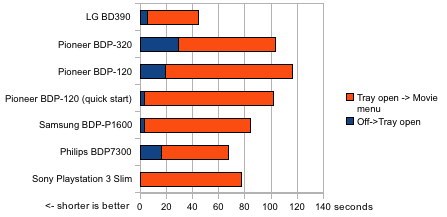
The Dark Knight (Blu-ray)
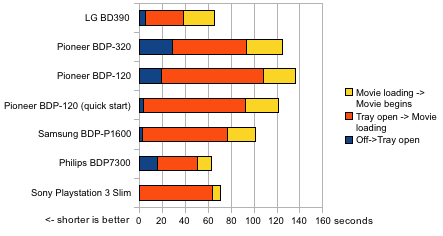
Pirates of the Caribbean: The Curse of the Black Pearl (DVD)
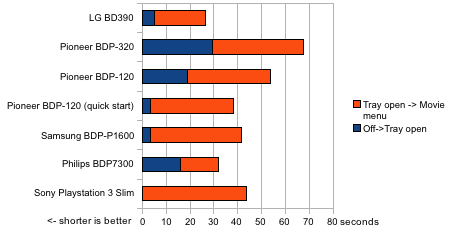
We also tested the power consumption a bit. You can find the official consumption figures usually in the manual. We didn't find anything too dramatic from the standalone players and as expected the PS3 Slim -- even with lowered power usage from the standard model -- was way above the others. PS3's consumption was two or three times that of a standalone player. The Pioneer BDP-120 with quick start on did also drain power quite a bit more (as listed in the manual) than any other player on standby.
Power consumption
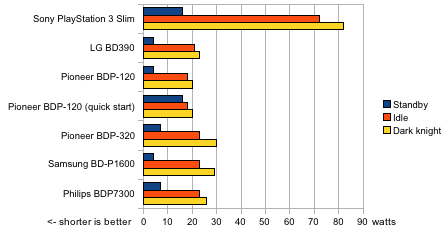
LG BD390,





Philips BDP-7300,




PS3 Slim,



Samsung BD-P1600,



Pioneer BDP-120,


Pioneer BDP-320,


File support
We expected some video file playback options from the Blu-ray players as even the cheapest of DVD players seem to support at least DivX nowadays. There is however a huge difference between the players' file support. LG has seemingly invested in file support the most. The PS3 Slim comes in second with Philips close behind. The LG BD390 also supports UPNP/DLNA shares as does PS3. All of the players excluding Pioneer BDP-120 support DivX playback but there are some minor differences in which features are supported. Philips BDP7300 is the only one that can handle DivX Ultra, which allows embedded menus and subtitles. On the other hand LG is the only one to sport support for high definition DivX.
Unfortunately for the Pioneer fans, neither of their players is able to playback any files from USB storage. You need to burn the files to a CD, DVD or BD disc to access them with the Blu-ray player. The USB ports are only meant for BD-Live content. The cheaper BDP-120 only supports JPEG files but the BDP-320 can also play DivX video with subtitles as well MP3 audio.
We also did a more comprehensive test with some of the most used audio and video formats. Here are the results...


LG BD390,





PS3 Slim,




Philips BDP-7300,




Samsung BD-P1600,



Pioneer BDP-320,


Pioneer BDP-120,

Picture quality
At first we didn't plan to do any kind of comparison for picture quality. However, as we got the IDT's HQV Benchmark DVD and Blu-ray we decided to give it a go. You need to change some settings from input and output devices before you can achieve valid results. This meant that the noise reduction, deinterlacing and resolution of both Blu-ray players and the TV had to be in a certain setting. PlayStation 3 Slim couldn't participate because of lack of deinterlacing and Pioneer BDP-120 because it didn't, for some reason (read: bug), allow us to change the output resolution (even though there's a setting for it). Additionally BDP-320 couldn't participate in the DVD Benchmark for not supporting 720p output resolution.
Because none of the players allowed us to turn the noise reduction off we didn't have anything to compare with. All in all the results are not the most accurate but should give you some indication on what kind of differences there are -- if any. This section will not be included in the final results.
Blu-ray Benchmark

DVD Benchmark

Conclusion
The tests and comparisons clearly demonstrated the differences between Blu-ray players and showed how different manufacturers have managed to create an affordable BD-Live enabled player. Pretty much the only test that did not result in conclusive differences between the standalone players was power consumption. There were large margin differences in features, performance, file support, user interface and usability. Eventually we found out that one device was above the rest. It all came down to versatility and value for money.
LG BD390




Features:





Appearance:




Remote:




UI and menus:





Performance:





File support:





Philips BDP7300




Features:




Appearance:



Remote:



Käyttöliittymä ja valikot:




Performance:




File support:




PlayStation 3 Slim



Features:




Appearance:



Remote:


UI and menus:




Performance:



File support:




Samsung BD-P1600



Features:



Appearance:




Remote:


UI and menus:



Performance:



File support:



Pioneer BDP-320



Features:


Appearance:





Remote:



UI and menus:



Performance:


File support:


Pioneer BDP-120


Features:


Appearance:



Remote:



UI and menus:


Performance:


File support:

Written by: Matti Robinson @ 19 Nov 2009 8:15

